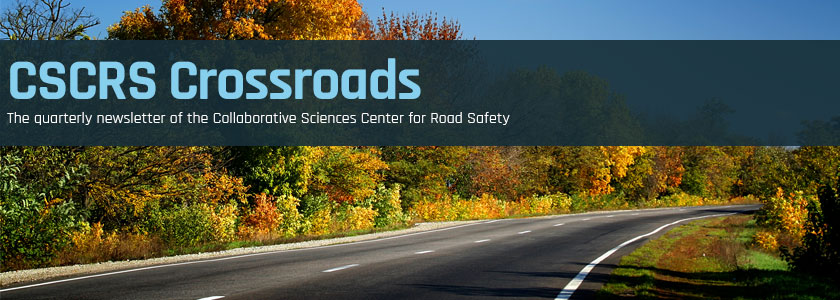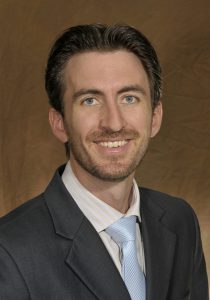You’re invited to Safety Sunday @ TRB
Going to the Transportation Research Board 99th Annual Meeting in Washington, DC? Please join CSCRS for the third annual Safety Sunday @TRB reception, Sunday, Jan. 12, 2020, 5 – 6:30 p.m. Eastern time. This event will bring together diverse entities to network and discuss critical themes in transportation safety research and practice. The reception will be held in the Marquis Salon 1&2 (M2) at the Marriott Marquis Washington, DC—this invite provides additional details:
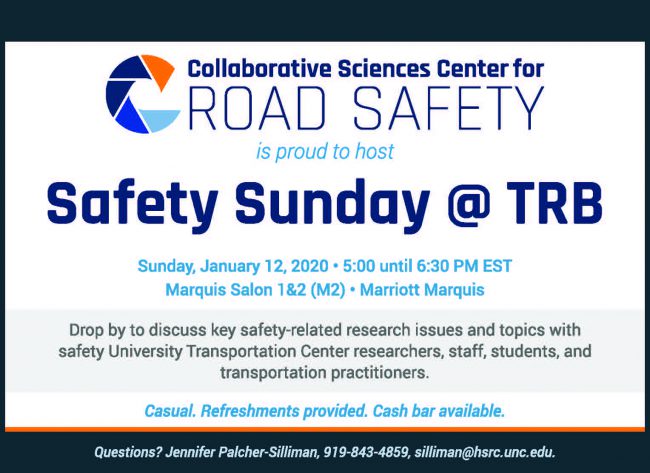
Here is a recap of last year’s Safety Sunday @ TRB. Also, while at TRB, do want to know where to learn about integrating safe systems principles into road safety? This list shows all CSCRS TRB sessions including workshops, lectern sessions, posters and more.
2019 CSCRS Student of the Year, Mary Wolfe

Mary Wolfe
CSCRS is proud to announce Mary Wolfe, a doctoral student in the City and Regional Planning program at the University of North Carolina at Chapel Hill, as its 2019 Outstanding Student of the Year. Wolfe will be recognized on Saturday, Jan. 11, at the Council of University Transportation Center’s 2020 Awards Banquet, held in conjunction with the TRB Annual Meeting.
“I’m really honored to be recognized as student of the year,” said Wolfe. “CSCRS supports exactly the kind of work that I have pursued as a doctoral student and an investigative approach that I think is crucial to the future of transportation research: it’s about illuminating the importance and intersectionality of transportation in pursuit of individual and community wellbeing—however we may measure it—across contexts and disciplines.” Learn more about Mary.
CSCRS launches 12 new transportation safety research projects
CSCRS recently launched 12 new research projects to explore a range of transportation safety topics including micromobility, urban freight, pedestrian/bicyclist injury data, shaping public discourse around road safety and integrating the features of a safe roadway system. This is the third round of research projects selected by CSCRS, bringing the total number of CSCRS funded research projects to 33.
The 12 new CSCRS research projects include:
- A systems approach to pedestrian safety, Phase II: Examining congestion pricing policies (led by Becky Naumann, UNC)
- Advancing crash investigation with connected and automated vehicle data (led by Michael Clamann, UNC)
- Applying civic innovation methods to advance safety education: A pilot program (led by Eric Dumbaugh, Florida Atlantic University)
- Crash risk for low-income and minority populations: An examination of at-risk population segments and underlying risk factors (led by Diana Mitsova, FAU)
- Developing a framework to combine the different protective features of a Safe System (led by Offer Grembek, University of California, Berkeley)
- Driver impairment detection and safety enhancement through comprehensive volatility analysis (led by Asad Khattak, the University of Tennessee-Knoxville)
- Factors and frames that shape public discourse around road user safety (led by Seth LaJeunesse, UNC)
- Reducing motorcyclist injuries: Engaging stakeholders to apply evidence-based countermeasures (led by Jerry Everett, UTK)
- Safety testing for connected and automated vehicles through physical and digital iterative deployment (led by Subhadeep Chakraborty, UTK)
- Understanding micromobility safety behavior and standardizing safety metrics for transportation system integration (led by Chris Cherry, UTK)
- Urban freight and road safety: Trends and innovative strategies (led by Noreen McDonald, UNC)
- Using integrated data to examine characteristics related to pedestrian and bicyclist injuries (led by Katie Harmon, UNC)
CSCRS posts all project materials, including final reports, slide decks and more, on its research projects page.
Don’t miss early bird discount for NaTMEC 2020 registration
Early bird registration is open for the National Travel Monitoring Exposition and Conference (NaTMEC) 2020, June 1-4, to be held at the Raleigh Convention Center in Raleigh, NC. NaTMEC provides travel monitoring professionals and transportation data users from around the world opportunities to share knowledge and good practices, exchange ideas, revisit fundamental concepts, learn new processes, procedures and techniques and see the latest advancements in policy, technology and equipment.
Rates for early registration until Feb. 17, 2020, are as follows:
- General: $550
- Speaker: $500

- Student: $75
- One day: $275
- Exhibitor (additional): $550
The NaTMEC 2020 program is being finalized and will be posted on the website soon. Information on travel and accommodations is available.
Exhibiting and sponsorship opportunities are available; learn more on the NaTMEC website or contact Jennifer Palcher-Silliman (silliman@hsrc.unc.edu) directly for more information.
CSCRS is coordinating the planning for the event, with support from the Federal Highway Administration. Stay tuned for other updates on the NaTMEC website.
Systems spotlight: CSCRS publishes article on integrating systems science into road safety
CSCRS researchers recently published the article “Integrating complex systems science into road safety research and practice, Part 2: applying systems tools to the problem of increasing pedestrian death rates” in the journal Injury Prevention. The piece was co-authored by UNC researchers Becky Naumann, Jill Kuhlberg, Laura Sandt, Stephen Heiny, Wes Kumfer, Steve Marshall and Kristen Hassmiller Lich. The article aims to provide a specific example of how systems dynamics tools can increase understanding of stakeholder “mental models” and generate robust systems-based hypotheses about the escalating problem of rising pedestrian death rates in the U.S.
Education and professional development: Quarterly review
CSCRS has engaged students and professionals in a variety of other learning activities over the last several months:
- FAU coordinated with the Urban Impact Lab, Dream in Green, AIA Miami, Miami Center for Architecture & Design, Inc., and the Health Foundation of South Florida to hold the Cardboard Challenge, October 2019, in Miami. The event was targeted toward K-5 schools in the area and focused around creative play, street safety and environmental stewardship.
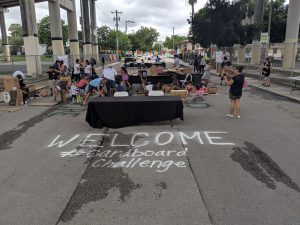
Cardboard Challenge
- Several CSCRS students were chosen as Dwight David Eisenhower Transportation Fellows in fall 2019. Two were UNC’s M. Clay Barnes, whose research covers health/safety outcomes related to e-commerce, and Libby Szuflita, whose research looks at traffic analysis zones. UCB also had several Eisenhower fellows.
- UCB also announced its fall 2019 CSCRS Road Safety Fellows.
- In its role on the Leadership Council for the Road to Zero Coalition, CSCRS researchers supported a fall webinar series, hosted by CSCRS advisory board members from the Vision Zero Network, Institute of Transportation Engineers and the National Safety Council. The series laid out principles of Safe Systems based on research and practices identified by CSCRS research and other sources. Here are the webinars (must have an account to access):
- In fall 2019, UNC staff taught the CSCRS-funded Road Safety Academy “Road Safety 101” web-based course to a group of 25 professionals from engineering, enforcement, planning, public health and other backgrounds. This course provided a broad safety background, integrated systems principles and prepared students to sit for the ITE-administered Road Safety Professionals Certification exam. A Road Safety Academy 201-level course is being planned for the spring of 2020.
Other CSCRS highlights
A quick rundown of additional recent CSCRS activities and recognitions: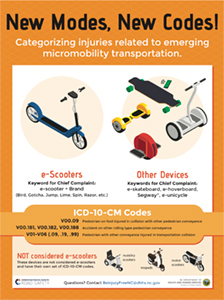
- CSCRS team members from UNC, UTK and UCB proposed a series of new International Classification of Diseases, Tenth Revision, Clinical Modification (ICD-10-CM) codes for categorizing injuries related to e-scooters and other micromobility devices to be included in an updated version of ICD-10-CM released in October 2020. This work is funded by CSCRS as part of the project Understanding micromobility safety behavior and standardizing safety metrics for transportation system integration. Here is a slide deck on early project findings, and here is the micromobility coding poster.
- UTK recently helped to develop the new standard, J3194, Taxonomy and Classification of Powered Micromobility Vehicles.
- In October 2019, CSCRS team members held the UNC-Chapel Hill Safe Systems Transportation Research Forum, a day devoted to meeting with Congressional staffers about important transportation safety research at UNC. CSCRS staff helped coordinate the event, and the staffers met with a variety of CSCRS researchers.
For more on CSCRS’s activities from the last several months, view the most recent Semi-Annual Progress Report.
CSCRS bookshelf
“The Future of the City,” Leo Hollis, Aeon, April 11, 2013
By Dev Seth
Dev Seth is a student researcher in the Duke Humans and Autonomy Lab.
Urban historian Leo Hollis’ article “The Future of the City” explores the property of resilience against extreme events in metropolitan areas. Well-informed by a litany of history examples, Hollis characterizes the city as an ecosystem composed of a multitude of moving parts, arguing that in order for this system to develop resiliency, both the human/sociological and the built/technological features of the city must be taken into account. To this end, he details innovative approaches taken by academic labs and city administrations to integrate systemwide real-time data from across a city, generating the pulse of a living, breathing entity that big data methods can utilize.
This integrated approach is already being explored in public transportation and ground traffic management, especially with the efficiency increases promised by smarter technologies and with connected autonomous vehicles on the horizon. Overall, I think Hollis’ article is worth reading for its interdisciplinary take on the “cities as systems” idea, one that definitely helped me think about urban mobility and transportation in a forward-looking, big picture way.
CSCRS Crossroads newsletters are archived here.



